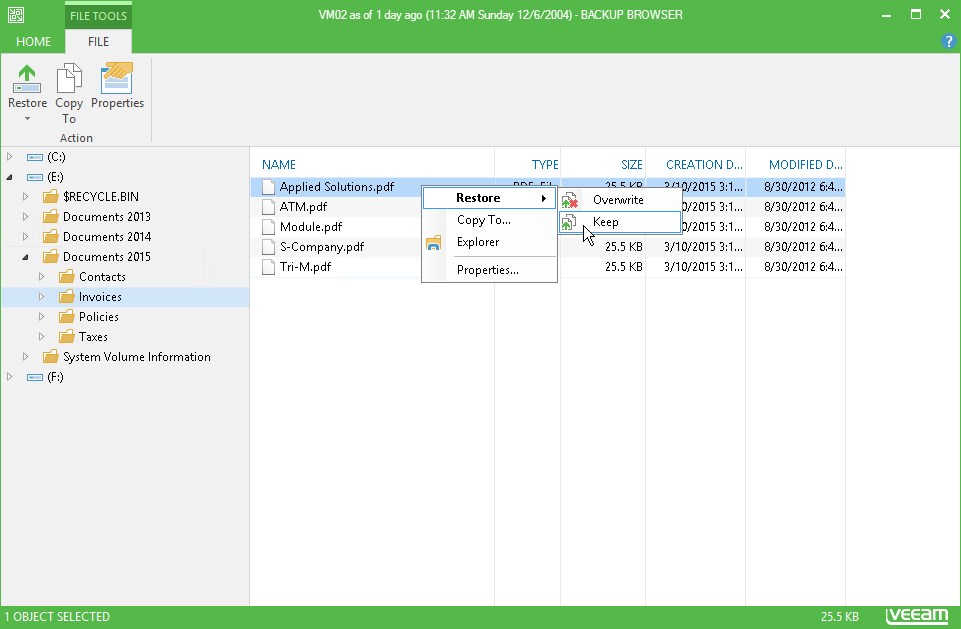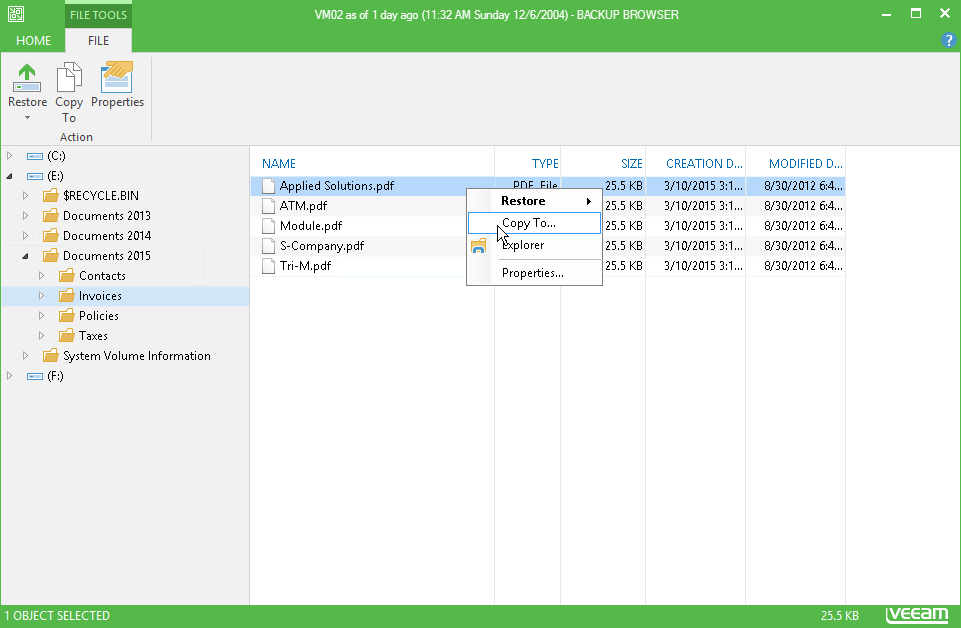At the Summary step of the wizard, click Finish to start the VM guest OS files restore process.
Once the restore process is complete, Veeam Backup Free Edition will open the Veeam Backup browser displaying the file system tree of the restored VM. Note that names of the restored VM hard disks may differ from the original ones.
You can perform the following operations with VM guest OS files in the Veeam Backup browser:
- Save files and folders to the original location
- Save files and folders to a folder on the backup server or in network shared folder
- Launch Veeam Explorers for application item restore
- Open files in Microsoft Windows Explorer
After the restore process is complete, close the Veeam Backup browser.
Saving Files to Original Location
To save files or folders to their initial location, right-click a file or folder in the Veeam Backup browser and select one of the following commands:
- To overwrite the original file on the VM guest OS with the file restored from the backup, select Restore > Overwrite.
- To save the file restored from the backup next to the original file, select Restore > Keep. Veeam Backup Free Edition will add the RESTORED- prefix to the original file name and save the restored file in the same location where the original file resides.
| IMPORTANT! | Restore to the initial location may fail if VMware Tools are not installed on the target VM. To restore guest OS files in such situation, you can use 1-click file-level restore in <%VBEM%> or save files to any other location and then move them to their initial location. |
To save restored files or folders to a folder on the backup server or in a network shared folder, right-click a file or folder in the Veeam Backup browser and select Copy To and select a location to which the file or folder must be copied.
When restoring file objects, you can choose to preserve their original NTFS permissions:
- Select the Preserve permissions and ownership check box to keep the original ownership and security permissions for restored objects. Veeam Backup Free Edition will copy files and folders with associated Access Control Lists and preserve granular access settings.
- Leave the Preserve permissions and ownership check box not selected if you do not want to preserve the original ownership and access settings for restored objects. Veeam Backup Free Edition will change security settings: the user who launched the Veeam Backup Free Edition console will be set as the owner of restored objects. Access permissions will be inherited from the folder to which restored objects are copied.
If you are restoring VM guest OS files of the virtualized Microsoft Active Directory Server, Microsoft Exchange Server, Microsoft SharePoint Server, Microsoft SQL Server or Oracle, you can launch a Veeam Explorer for the necessary application directly from the Veeam Backup browser.
- To start Veeam Explorer for Active Directory, browse to the Microsoft Active Directory database file (DIT) in the Veeam Backup browser, select it and click Application Items > Active Directory Items on the Home tab or double-click the DIT file.
- To start Veeam Explorer for Exchange, browse to the Microsoft Exchange database file (EDB) in the Veeam Backup browser, select it and click Application Items > Exchange Items on the Home tab or double-click the EDB file.
- To start Veeam Explorer for SharePoint, browse to the Microsoft SharePoint content database (MDF) in the Veeam Backup browser, select it and click Application Items > SharePoint Items on the Home tab or double-click the MDF file.
- To start Veeam Explorer for Microsoft SQL, browse to the Microsoft SQL database file in the Veeam Backup browser, select it and click Application Items > SQL Server Databases on the Home tab or double-click the Microsoft SQL database file. For more information, see http://technet.microsoft.com/en-us/library/ms143547.aspx.
- To start Veeam Explorer for Oracle, browse to the Microsoft Oracle content database in the Veeam Backup browser, select it and click Oracle on the Home tab or double-click the database file.
You can use Microsoft Windows Explorer to work with restored files and folders.
To open Microsoft Windows Explorer:
- Click Explore on the ribbon in the Veeam Backup browser or right-click the necessary folder and select Explore.
- Veeam Backup Free Edition will launch Microsoft Windows Explorer. Browse to the necessary VM guest OS files.
You can also start Microsoft Windows Explorer from the Start menu of Microsoft Windows and browse to the necessary VM guest OS files. VM disks are mounted under the C:\veeamflr\<vmname>\<volume n> folder on the backup server.
You can browse restored files and folders only while the Veeam Backup browser is open. After the Veeam Backup browser is closed, Veeam Backup Free Edition unmounts the VM disks from the temporary VM.
It is recommended that you close the Veeam Backup browser after you have finished restoring files and folders. In the opposite case, the backup file(s) from which you restore VM guest OS files may remain locked and operations using the file(s) may fail.
Veeam Backup Free Edition checks if there is any activity in the Veeam Backup browser every 5 minutes. If the user or Veeam Backup Free Edition components and services have not performed any actions for 30 minutes, Veeam Backup Free Edition displays a warning notifying that the Veeam Backup browser will be closed within 5 minutes.
After the warning is displayed, you can perform one of the following actions:
- You can close the Veeam Backup browser manually.
- You can click Cancel to postpone the close operation. In this case, the Veeam Backup browser will remain open for 5 minutes. After this period expires, Veeam Backup Free Edition will display the warning again.
- You can perform no action. In this case, the Veeam backup browser will be automatically closed in 5 minutes.










